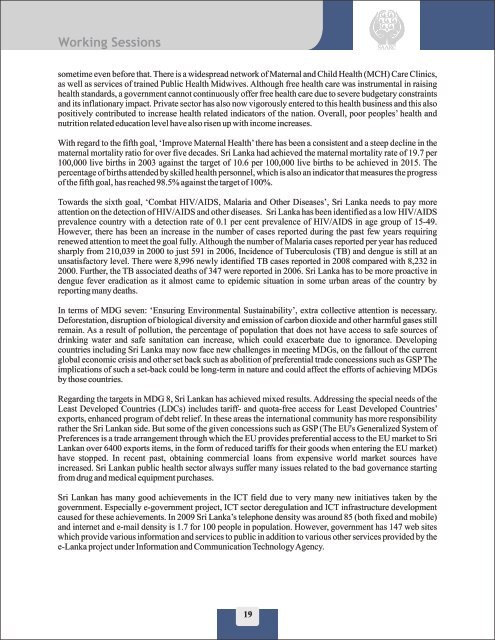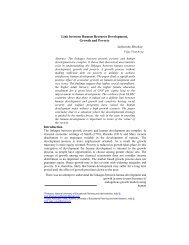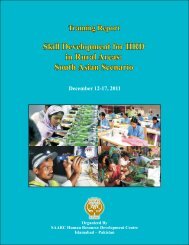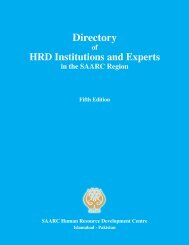Training Report: Millennium Development Goals in the SAARC Region
Training Report: Millennium Development Goals in the SAARC Region
Training Report: Millennium Development Goals in the SAARC Region
You also want an ePaper? Increase the reach of your titles
YUMPU automatically turns print PDFs into web optimized ePapers that Google loves.
Work<strong>in</strong>g Sessions<br />
sometime even before that. There is a widespread network of Maternal and Child Health (MCH) Care Cl<strong>in</strong>ics,<br />
as well as services of tra<strong>in</strong>ed Public Health Midwives. Although free health care was <strong>in</strong>strumental <strong>in</strong> rais<strong>in</strong>g<br />
health standards, a government cannot cont<strong>in</strong>uously offer free health care due to severe budgetary constra<strong>in</strong>ts<br />
and its <strong>in</strong>flationary impact. Private sector has also now vigorously entered to this health bus<strong>in</strong>ess and this also<br />
positively contributed to <strong>in</strong>crease health related <strong>in</strong>dicators of <strong>the</strong> nation. Overall, poor peoples’ health and<br />
nutrition related education level have also risen up with <strong>in</strong>come <strong>in</strong>creases.<br />
With regard to <strong>the</strong> fifth goal, ‘Improve Maternal Health’ <strong>the</strong>re has been a consistent and a steep decl<strong>in</strong>e <strong>in</strong> <strong>the</strong><br />
maternal mortality ratio for over five decades. Sri Lanka had achieved <strong>the</strong> maternal mortality rate of 19.7 per<br />
100,000 live births <strong>in</strong> 2003 aga<strong>in</strong>st <strong>the</strong> target of 10.6 per 100,000 live births to be achieved <strong>in</strong> 2015. The<br />
percentage of births attended by skilled health personnel, which is also an <strong>in</strong>dicator that measures <strong>the</strong> progress<br />
of <strong>the</strong> fifth goal, has reached 98.5% aga<strong>in</strong>st <strong>the</strong> target of 100%.<br />
Towards <strong>the</strong> sixth goal, ‘Combat HIV/AIDS, Malaria and O<strong>the</strong>r Diseases’, Sri Lanka needs to pay more<br />
attention on <strong>the</strong> detection of HIV/AIDS and o<strong>the</strong>r diseases. Sri Lanka has been identified as a low HIV/AIDS<br />
prevalence country with a detection rate of 0.1 per cent prevalence of HIV/AIDS <strong>in</strong> age group of 15-49.<br />
However, <strong>the</strong>re has been an <strong>in</strong>crease <strong>in</strong> <strong>the</strong> number of cases reported dur<strong>in</strong>g <strong>the</strong> past few years requir<strong>in</strong>g<br />
renewed attention to meet <strong>the</strong> goal fully. Although <strong>the</strong> number of Malaria cases reported per year has reduced<br />
sharply from 210,039 <strong>in</strong> 2000 to just 591 <strong>in</strong> 2006, Incidence of Tuberculosis (TB) and dengue is still at an<br />
unsatisfactory level. There were 8,996 newly identified TB cases reported <strong>in</strong> 2008 compared with 8,232 <strong>in</strong><br />
2000. Fur<strong>the</strong>r, <strong>the</strong> TB associated deaths of 347 were reported <strong>in</strong> 2006. Sri Lanka has to be more proactive <strong>in</strong><br />
dengue fever eradication as it almost came to epidemic situation <strong>in</strong> some urban areas of <strong>the</strong> country by<br />
report<strong>in</strong>g many deaths.<br />
In terms of MDG seven: ‘Ensur<strong>in</strong>g Environmental Susta<strong>in</strong>ability’, extra collective attention is necessary.<br />
Deforestation, disruption of biological diversity and emission of carbon dioxide and o<strong>the</strong>r harmful gases still<br />
rema<strong>in</strong>. As a result of pollution, <strong>the</strong> percentage of population that does not have access to safe sources of<br />
dr<strong>in</strong>k<strong>in</strong>g water and safe sanitation can <strong>in</strong>crease, which could exacerbate due to ignorance. Develop<strong>in</strong>g<br />
countries <strong>in</strong>clud<strong>in</strong>g Sri Lanka may now face new challenges <strong>in</strong> meet<strong>in</strong>g MDGs, on <strong>the</strong> fallout of <strong>the</strong> current<br />
global economic crisis and o<strong>the</strong>r set back such as abolition of preferential trade concessions such as GSP The<br />
implications of such a set-back could be long-term <strong>in</strong> nature and could affect <strong>the</strong> efforts of achiev<strong>in</strong>g MDGs<br />
by those countries.<br />
Regard<strong>in</strong>g <strong>the</strong> targets <strong>in</strong> MDG 8, Sri Lankan has achieved mixed results. Address<strong>in</strong>g <strong>the</strong> special needs of <strong>the</strong><br />
Least Developed Countries (LDCs) <strong>in</strong>cludes tariff- and quota-free access for Least Developed Countries’<br />
exports, enhanced program of debt relief. In <strong>the</strong>se areas <strong>the</strong> <strong>in</strong>ternational community has more responsibility<br />
ra<strong>the</strong>r <strong>the</strong> Sri Lankan side. But some of <strong>the</strong> given concessions such as GSP (The EU's Generalized System of<br />
Preferences is a trade arrangement through which <strong>the</strong> EU provides preferential access to <strong>the</strong> EU market to Sri<br />
Lankan over 6400 exports items, <strong>in</strong> <strong>the</strong> form of reduced tariffs for <strong>the</strong>ir goods when enter<strong>in</strong>g <strong>the</strong> EU market)<br />
have stopped. In recent past, obta<strong>in</strong><strong>in</strong>g commercial loans from expensive world market sources have<br />
<strong>in</strong>creased. Sri Lankan public health sector always suffer many issues related to <strong>the</strong> bad governance start<strong>in</strong>g<br />
from drug and medical equipment purchases.<br />
Sri Lankan has many good achievements <strong>in</strong> <strong>the</strong> ICT field due to very many new <strong>in</strong>itiatives taken by <strong>the</strong><br />
government. Especially e-government project, ICT sector deregulation and ICT <strong>in</strong>frastructure development<br />
caused for <strong>the</strong>se achievements. In 2009 Sri Lanka’s telephone density was around 85 (both fixed and mobile)<br />
and <strong>in</strong>ternet and e-mail density is 1.7 for 100 people <strong>in</strong> population. However, government has 147 web sites<br />
which provide various <strong>in</strong>formation and services to public <strong>in</strong> addition to various o<strong>the</strong>r services provided by <strong>the</strong><br />
e-Lanka project under Information and Communication Technology Agency.<br />
19
















